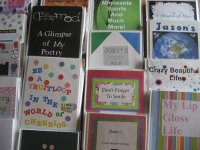Five Poetry Teaching Tips for New Teachers
Your content has been saved!
Go to My Saved Content."As a child I walked with noisy fingers along the hemline for so many meadows back home." - Jewel
I love to read poetry for many reasons, but some that strike me as being the most important are:
- Reading poetry relaxes me.
- Reading poetry makes me laugh!
- Reading poetry allows me to see into a deeper, more emotional part of myself.
Do you feel the same way? Maybe not -- and no surprise there! Often, we deny our students the experience of great content, such as poetry, because:
- We don't want to teach it.
- We're simply unsure of how to teach it.
- We didn't have a good experience with it ourselves.
As April is National Poetry Month, a few weeks ago on New Teacher Chat, I choose the topic of sharing poetry teaching strategies for the simple reason that I wanted new (pre-service) teachers and their students to feel comfortable with experiencing poetry. I wanted them to have not only resources to use with their students, but actual strategies to support them in making poetry come alive in their classrooms. A surprising number of new and veteran teachers showed up for this Poetry Chat with a big bag of tips and tricks! Today, I'm sharing five tips for teaching poetry, including some from the chat, that new (and experienced) teachers might benefit from using.
1. "I Am" Poem
An "I Am" poem is a good way to introduce poetry to children, because it allows them to focus on their own characteristics. The process is simple. The "I Am" poem is made up of three stanzas that are six lines each. It follows a specific format with the intention of describing something, often a person or an object. The beginning of each line is already written, and the writer fills in the end of the line by inserting a specific word or words. A simple strategy that all kids will find interesting, it's easy enough to implement and a great process for student self-expression. As you read their "I Am" poems, you might get to know your kids on a deeper level.
2. Shape Poetry
Explain the process for shape poems, which entails starting with a shape and building a poem from there. Some examples of shape poems are haiku, diamantes and acrostics. Shape poetry has to do with the physical form of the words on the paper. While the words, writing style and literary devices all impact the poem's meaning, the physical shape that the poem takes is significant. Combining content and form creates a powerful poem. This is a simple and fun way to get started with poetry in the classroom, and kids of all grade levels will enjoy it.
3. Turn Poems into Illustrations
Have students select a favorite poem and illustrate it. This can be done on paper, digitally, on a large sheet of butcher paper on the ground, or on the sidewalk by your classroom. You can use crayons, markers, paint or chalk. Get the kids talking about their poems while illustrating, or just let them draw. After this activity invite the class to do a "poetry walk" around the room or drawing space to share their impressions of the illustrated poems. Invite others to see the poetry-art. Consider pairing up with a colleague who might want to do this activity with you. Take photos of the poetry art to archive for later discussion. This is a great, easy way to start exploring poems and poets while mixing the medium of art in the process.
4. Use Music to Teach Poetry
Have students pick a favorite song. (You may have to do a little screening here.) Next, have them share the song lyrics by reading them as they would a poem. Engage them in conversation about the similarities they note between song lyrics and poetry. Have them "investigate" the poetry in lyrics. Then, using a smartphone or tablet device, consider taking the time to video your budding classroom poets reading their favorite lyrics -- or have them do it. You can upload your content to YouTube Teachers. If that's not an option, use or create your own YouTube channel and start a regular poetry feature. As an example, my channel is Teaching with Soul YouTube. See if this lyric reading helps your students feel more connected to the idea of poetry in their daily lives.
5. Create Your Own Poem in Your Pocket Day
Using ideas from Poets.org, you can bring this alive in your classroom easily. For example, on any day you choose, have your students create bookmarks with favorite lines from a favorite poem. Do a think-pair-share and have students chat about why they choose those specific lines. Did it remind them of something in their lives? A sad or happy experience? Also on that day, project a poem on the wall or on your interactive whiteboard (IWB) and have students read it aloud with you or to each other. Talk about how the poem makes them feel. Discuss any similarities students have as they experience their poems. Have them do a reflective poem of their own in a notebook or journal. Take time to have students read them aloud if they feel comfortable.
No doubt there are more strategies that you would add to this list. However, now that you have five, are you encouraged to delve a little deeper with teaching poetry this month? Just incase you're unsure, I took the time to curate a Poetry Board on Pinterest that will support you to get started. Let me know what you think!
